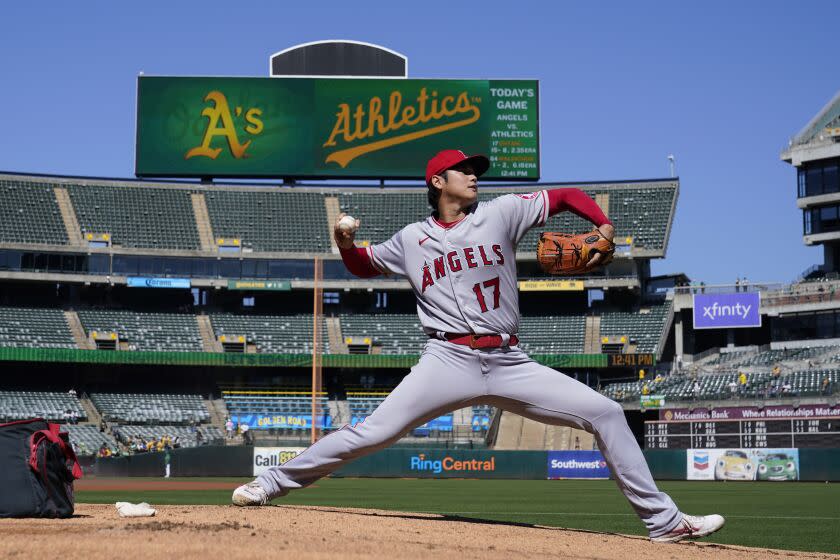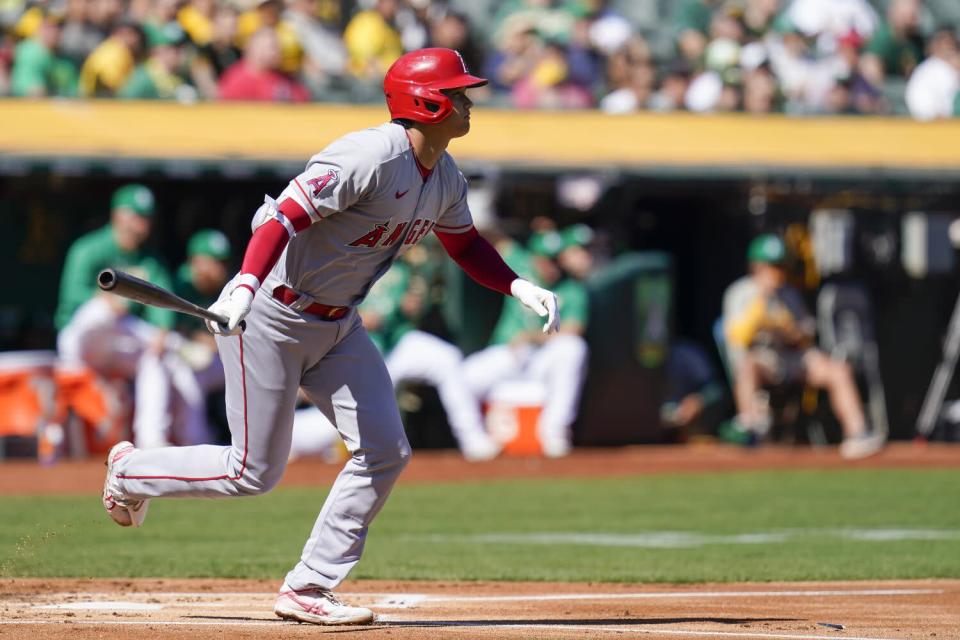
Who was that on the mound?
He looked like Shohei Ohtani.
He smiled like Shohei Ohtani.
He just didn’t pitch like Shohei Ohtani.
In another MVP-caliber season in which Ohtani became the only player in history to qualify for both the earned-run average and batting crowns, the extent of his talent was reflected as much by his transformation as a pitcher and his unprecedented workload.
Now four years removed from reconstructive elbow surgery, his transition from thrower to pitcher was complete.
Ohtani was the starting pitcher for the Angels in their season finale Wednesday, a 3-2 defeat to the Oakland Athletics.
Pitching with a blister on his middle finger, the Japanese right-hander had a perfect game through four innings. He completed five innings and was charged with a run, a walk and a hit. He struck out six.
The most striking statistic: Of his 69 pitches, only four were four-seam fastballs, according to Major League Baseball’s PITCHf/x tracking system.
Ohtani also threw only four four-seamers in his start before that, in which he carried a no-hitter against the Athletics into the eighth inning at Angel Stadium.
He threw the pitch more than 44% of the time last year. This season Ohtani dramatically decreased his use of his four-seamer after the All-Star break as he prioritized movement and location.
Ohtani can touch 101 mph with the pitch but virtually abandoned it, utilizing his slider as his primary weapon and adding a complementary power sinker in the middle of the season.
On the season, his four-seamer accounted for just 28% of his pitches. His slider became his most frequent offering, at close to 39%.
Ohtani finished the season with a 15-9 record and a 2.33 ERA while batting .273 with 34 home runs and 95 runs batted in.
He registered a 1.94 ERA in his last 16 starts.
“I pitched this year while testing out a lot of things,” Ohtani said in Japanese. “Next year and beyond, if I can problem solve more and more, I think I can leave better numbers.”
In spring training, Ohtani said he thought his MVP season last year would be a baseline for future performances. He sounded certain he would improve — the question was, by how much?
His evolution as a pitcher this year points to him remaining on an upward trajectory. Once again, the question is about how much better he can get. If there’s a limit on what he can do, he hasn’t found it yet.
“He’s continuing to get better, that’s the thing,” catcher Max Stassi said. “As a former MVP, the bar’s set high, the expectations are high and he lives up to those and he tries to overshoot those even more the following year.”


He’s willing to learn, Angels officials saying no player makes greater use of the data and technological tools made available by the team.
But equally, if not more important is his capability to learn.
Ohtani was viewed in the industry as a more advanced hitter than a pitcher, his exploits more a byproduct of his physical gifts than technical mastery. His control was considered second-rate by Japanese standards.
So much for that.
Mike Trout spoke with the enthusiasm of a Little Leaguer when talking about Ohtani’s pitching acumen.
“It’s so fun to watch and to be part of in the outfield, see the pitches that he’s throwing,” Trout said. “It seems like every day, he’s coming in working on new pitches. He’s coming in laughing, ‘Oh, I got a gyro, little slider that goes up and down today.’ It’s unfair.”
In a mid-August start against the Seattle Mariners, Ohtani unveiled a sinker that he hadn’t previously thrown.
As time passed, he threw the pitch more and more, and why wouldn’t he? The pitch could touch 101 mph and he could command it better than his four-seamer.
Ohtani finished the season with 219 strikeouts in 166 innings.
He spoke carefully when addressing his future, refusing to speculate on whether he would remain with the Angels beyond next year. Ohtani will be eligible to be a free agent at the end of next season.
About his only remarks on the future pertained to how he intended on bettering himself, particularly as a hitter.
Reminded that he raised his average from .257 last year to .273 while reducing his strikeout rate from 29.6% to 24.2%, Ohtani said he came into this season wanting to hit close to .300.
He thinks the approach cost him home runs. He finished with 34, a dozen fewer than last season.
“What stood out a little were the balls that died right in front of the fence,” he said.
He noticed this was especially the case when he hit the opposite field.
But, he said, “I think if I can grow just a little more, both [the home runs and average] will increase.”
Ohtani is human and has a ceiling like everyone else. But his hasn’t come into sight yet, and if he’s determined to homer more next season, he should homer more next season. Compared to what he did on the mound this year, that would be just a minor improvement.
This story originally appeared in Los Angeles Times.
